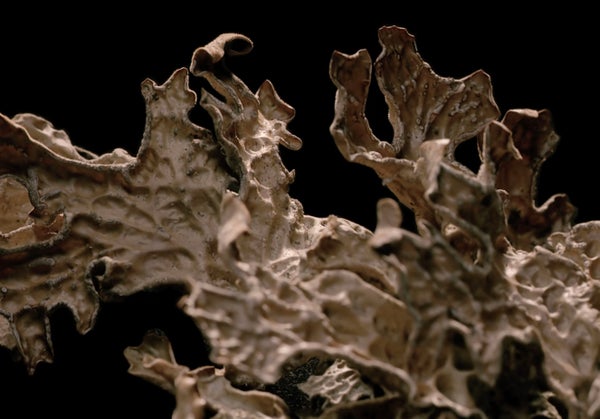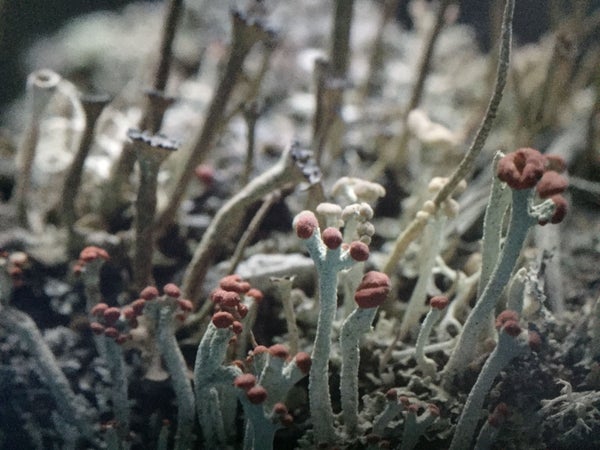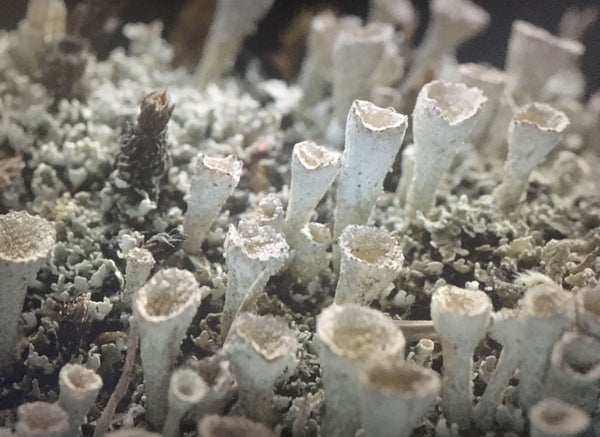This article was published in Scientific American’s former blog network and reflects the views of the author, not necessarily those of Scientific American
Author’s note: In 2017 I wrote an article about lichens in Scientific American featuring Trevor Goward, a self-taught lichenologist who lives in rural British Columbia. His ideas and questions about the lichen symbiosis between algae and fungus have inspired numerous scientific studies. Anishinaabe filmmaker Lisa Jackson, who lives in Toronto, read the article and was inspired to make an IMAX film titled Lichen, featuring otherworldly close-up shots of lichens with narration from Goward. Jackson’s film is screening at Sundance Film Festival, happening now. The following conversation with Jackson and Goward has been edited for clarity.
Erica Gies: What about the article inspired you to make the film?
Lisa Jackson: I saw the images of lichen, which were so stunning—
On supporting science journalism
If you're enjoying this article, consider supporting our award-winning journalism by subscribing. By purchasing a subscription you are helping to ensure the future of impactful stories about the discoveries and ideas shaping our world today.
Gies: By photographer Tim Wheeler.
Jackson: —and read about the perspective that lichens can offer us. That combination really struck me both aesthetically and philosophically. So, I took these small things—some of the specimens in the film are about the size of a quarter—and shot it with magnifying lenses to basically put us inside the lichen. There's something really inspiring about looking closely at an organism that works symbiotically in community and adapts to its surroundings and can live in very harsh environments and survive there, particularly in light of the climate crisis.
Trevor Goward: Viewing the film, I felt like we were looking at a postapocalyptic scene—you know, there’s been some explosion and there are bits and pieces floating out in space. And looking at these beautiful lichens and their substrates from different perspectives loosens up the viewer to the idea of accepting other ways of seeing things, which is desperately needed at this time.
Gies: Yeah. Some of the close-ups looked like something else, like mountains or water. And by altering our perspective to such a degree, it pushed us to really question what we were seeing, which is the perfect nudge to get the viewer to consider lichens’ wider significance.
Jackson: Thank you both. Yeah, it's literally trying for a new perspective. In the article that you wrote, Erica, Trevor's appreciation of Indigenous knowledge is mentioned briefly. I'm an Anishinaabe filmmaker and felt a resonance between Trevor’s observational approach in his study of lichen and Indigenous science, which sees our environment as whole, all the parts integrated in relationship. Is there a shift in how science is looking at Indigenous knowledge or should there be?
Gies: A subtheme in my story was what science has lost—broader perspective, insight into how things are connected—in recent decades with hyperspecialization. On the other hand, in my wider reporting, I have found that some scientists are increasingly recognizing that Indigenous wisdom has a lot to offer, particularly as we face climate change and the dramatic loss of biodiversity.
Jackson: Right. I was speaking to Leroy Littlebear, a Blackfoot Elder who looks at the intersections between Indigenous and Western science, and he said the Euro-Western concept of science is really about specialization. And us Indigenous folks are generalists. We know a little bit about everything and we're able to see how all those pieces interact in the real world.

Credit: Lisa Jackson
Goward: I think the divergence in these two approaches stems from different worldviews. Overall, the Indigenous person and the naturalist are seeking a broader contextual frame, what we'd call wisdom, whereas science is about getting power over things. I mean, not every scientist is about that, but the world would not be where it is now unless, on the back of science, some people had not figured out how to convert resources into personal wealth. But the piecemeal approach of science—taking it to bits and pieces and putting it together in ways that are convenient—can skew understanding because it is simply not how things are. The world works in a much more integrative way.
Gies: What you are calling power versus wisdom, I would call control versus respect. In my reporting I often see science called upon to control nature, such as with a hydropower dam. To that end, it frequently takes the approach of trying to solve one problem without recognizing the ways in which the system’s components are linked to so many other things, and that's why you get unintended consequences.
Whereas a naturalist or an Indigenous perspective is rooted in the idea that other beings are our kin. In my story, biologist and author David George Haskell points out that was fundamentally Darwin's point in his theory of evolution. And Darwin was, at heart, a naturalist. Since then, to some extent, science has moved away from that, subscribing to the mainstream belief that humans are more important than other beings and that serving our needs should take priority—even if that need is increasing shareholder profits.
Goward: There’s inherent conflict between the ideas of world as resource versus world as home. If there is to be a livable future, it will come from some sort of honest engagement and mutual respect between the two ways of seeing.
Jackson: Good scientists acknowledge the limitations of their understanding. They can only evaluate things they can measure, and not everything is measurable. That’s where the role of story in Indigenous knowledge comes in. Narrative can convey knowledge in more complex ways, the form itself provoking a different level of attention that yields understanding.
Actually, that makes me think of something I would like to better understand. In the film, Trevor talks about lichens’ emergent properties. Trevor, can you tell us a bit more about emergence? And how that relates to the idea that the world itself has agency and so everything is in the process of becoming?
Goward: Lichens are the easiest way in to understanding emergence because when the symbiotic partners come together, they produce something with characteristics not found in the parts: a lichen. In short, emergence is when something becomes more than the sum of its parts. When you start looking around, you understand that that is actually the foundation of everything. And as for the world having agency: the world isn’t thinking the way you and I think. But the way in which the world responds looks like thinking. For example, a lichen responds to what's going on around it, and its response is its agency. The same is true of the living world.

Credit: Lisa Jackson
Gies: So, when you say agency, you mean the outward manifestation of its internal processes?
Goward: Yeah. And time is a component in this. In the biological world, everything in the past is an emergent property because it's the outward manifestation, or outcome, of volition. Everything in the future is volition itself: what it feels like to respond to the perception of change. By that I mean every organism has the capacity to make decisions, and the decisions it makes are learned behavior, shaped by experience—what it feels like to be that organism at that moment in its existence.
Jackson: Your description of agency, then, is compatible with Indigenous cultures’ idea of "all our relations." Even rocks, the sun, the stars are considered our living relatives. And it’s fascinating to me how scientific discoveries can track different cultures’ stories. For example, one of the building blocks of life on Earth is phosphorus. And astronomers just discovered that phosphorus is created when baby stars emerge out of star fields, which could have traveled to the Earth via comets. And I thought, this is really interesting, because many Indigenous creation stories say that we are related to the stars and we come from the stars. Wilfred Buck, a Cree Elder who specializes in star knowledge, told me that, in his language, asteroids and comets that enter the atmosphere are called acak paytukosin, meaning “spirits coming” or “life coming.”
Gies: Interesting! That is similar to the point in my article where Stuart Crawford, an ethnobotanist, was talking about how some of the guidelines that Indigenous people have for harvesting lichens as food aren't necessarily "accurate" from a scientific perspective, but they often end up at the same place, which I think validates this idea that there are different ways of knowing.
Another question: For Indigenous people who have remained on their land, how is climate change altering the things they know about their land? And given those changes, can Indigenous knowledge still aid climate science?
Jackson: I think so. The Indigenous perspective, rooted in respect, is about caretaking. That’s because the Indigenous worldview posits that humans are the most vulnerable of all the living creatures on the planet.
Gies: That's really interesting. I think that's completely at odds with what most humans today believe.
Jackson: Correct. Which is that humans are the most advanced and important and everything else is underneath us. But it's exactly the opposite. And that means our best hope of a good life lies in our ability to observe carefully the balance among all the cycles of nature and then play our part to ensure that those cycles continue. That perspective would really benefit greater society, versus the viewpoint that we can measure a resource numerically and just use until it's almost gone. It looks at things almost like a store shelf, you know? Until the last box of cereal is sold, there's still cereal.
Goward: Actually, a lichen’s agency is exercised in a way that echoes this Indigenous perspective. A lichen works because its alga, fungus, etc. see themselves as parts of the whole and act accordingly, and the whole gives resilience to the parts.
As for people, the reason that most don't see human frailty is because, to varying degrees, we're inside technological bubbles that protect us. For example, if you pollute your river, it doesn't matter because you just build a water purification plant to deliver clean water to your tap. That works until it doesn't. Eventually, as is happening now with climate change, the bubbles break, and people find themselves vulnerable to severe weather or whatever's happening. And it's far more catastrophic than it would be if people were really living in their place instead of living inside the bubble, which allows us to maintain fairy tales about the reality of the world.
Gies: Well put.
Goward: Also, as you mentioned, Erica, climate change is altering the things that Indigenous peoples—and naturalists—know about their places, making that specific knowledge potentially less relevant. But a core element of these traditions is attentiveness, just being present, watching what's going on, and that continues to be useful—I mean, it would be if we lived in a world where other people listened to them.
Lichen Trailer from Lisa Jackson on Vimeo.
